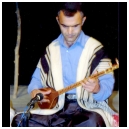Achaemenid Karna sound in Zagros Mountains range
- ‹ previous
- 4 of 4
Achaemenid Karna sound in Zagros Mountains range
Nowadays, Karna is a Persian folk music instrument that is being used by the people of Bakhtiyari and Qashqayee tribes, but in ancient eras it was known as a military and governmental instrument. Karna is made of wood and brass so we can't categorize in wood wind or brassy wind. Karna is often played with along Dohol in Bakhtiyari tribes and with Naghareh in Qashqayee tribes, in wedding, festive ceremonies, funeral, horse ridding and war. This instrument has a very aloud sound so that was mainly played in outdoors

Listen to the Dastmal Bazi (wedding ceremony song) with Karna
Listen to the Choob Bazi (wedding ceremony song) with Karna
Listen to the Chapi (funeral ceremony song) with Karna
Listen to the Savar Bazi (horse ridding song) with Karna
Historical Background
Its history dates back to the Achaemenian dynasty (550-330 B.C.E.), Persian Empire. Karna had been the main instrument at Achaemenian era. Herodotus the Greek historian has written: "in great Cyrus era, army forces attacked with bugle alarm". Strabo the Greek historian, geographer and philosopher has written about that: the son of kinglets and young princes was wake up with Karna song and provide themselves to some military practices before sunrise

Moreover Based on the very old music instrument found in Persepolis in 1957, we can guess Karna almost dates back to 2270 years ago at least. This ancient piece that made of gunmetal, had found from the Last Achaemenian king, third Darius grave (died 330 B.C.E), in Fars province south of Iran. It usually called Achaemenian Karna however in historical hand scripts has been written Persian Karna. This cone shape has 120 cm Length, 5 cm inside and 50 cm outside embouchure diameter

Structure
The Karna belongs to aerophone instruments family. That's large-Trumpet-like instrument but in playing same as oboe. Karna can be categorized in double reed musical instruments of the woodwind family. It is consist of three parts, reed section that called Mil Karna in Persian, a wood part so player fingers can stay on and finally we have a metallic cone shape same as bugle. The wood part of this instrument has 9 holes, 8 on the front and one on the back of it. It's usually made of ebony or other tough woods. Nowadays, total size of Karna is changeful between 75-110 centimeters in length

Listen to the Karna song by Abd-e Mohammad
Playing and players
Karna has a range of one octave generally but virtuoso players can produce more notes, almost two octaves

The embouchure is the use of facial muscles and the shaping of the lips to the mouthpiece of a wind instrument. Primitive sound is produced when a stream of air is directed by facial muscles toward the reed of the instrument. Then, the sound would be circulated inside the wood part wherever is made a melody by player fingers and finally it would be passed from cone shape with a distinct timbre and very aloud sound

Listen to the Karna song of Qashqayee tribes
The best players of Karna live in Zagros Mountain range, Khuzestan and Bakhtiyari provinces, south west of Iran. The most famous one is Nurollah Momen Nejad and other is Soltan Morad Fathipur. Of course some of them live in Qashqayee and Boyer Ahmad zones, in Fars province

Listen to the Karna song by Nurollah Momen Nejad
New experiences
Nowadays, Karna is used usually by Dohol or Naghareh (Persian percussion) but in recent years some new experiences happened for it. First, in 1990 Khosrov Soltani with Hossein Alizadeh's cooperation made an album for ancient instruments that called "No Bang-e Kohan". Soltani in this album performed and experienced some new sonority by Sorna and Karna ensemble
Listen to the Karna ensemble by Khosrov Soltani
Second experience in this field happened by myself. In 2005 I arranged a folk song for Karna and Persian plucked instruments. Karna with Dohol accompany performed their melody and I added some musical effects by Tar, Setar and Tarbass
Listen to the Karna ensemble with Persian plucked instruments
My last experience in 2008 is a quartet for Karna ensemble and Dohol accompany. 4 Karnas performed their specific lines while they create a new atmosphere. This piece had made based on Bakhtiyari music repertory
Listen to the Karna ensemble quartet
Thanks to Zahra Alikahi
previous article: What do you know about DoTar
- SAMANI's blog
- Login to post comments
-




